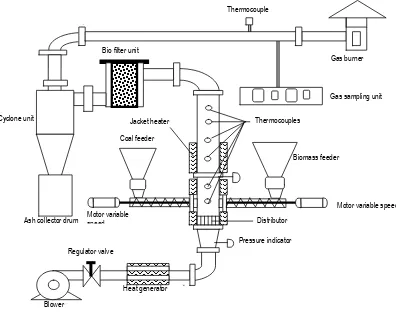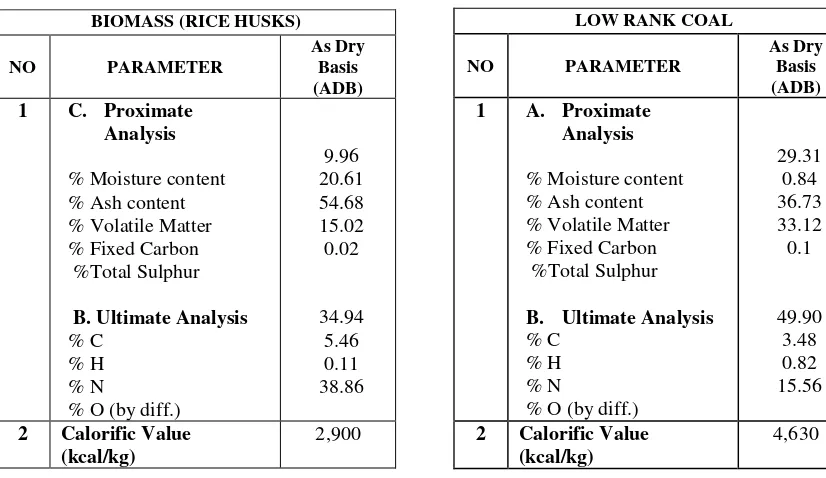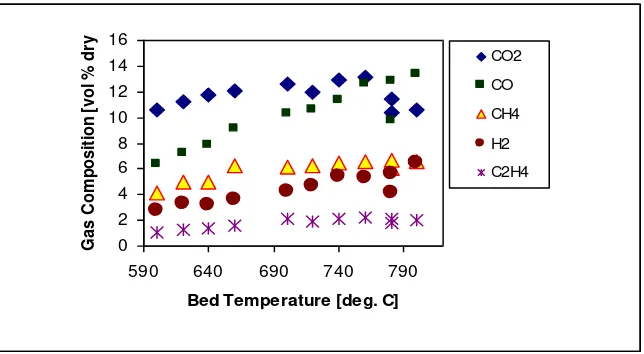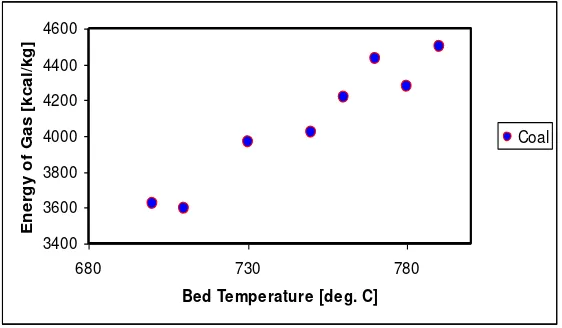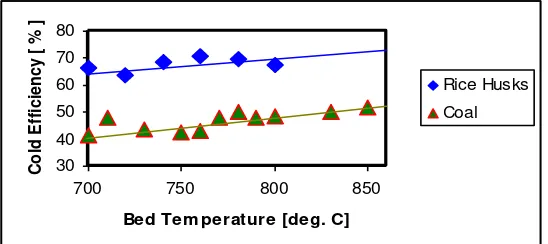PERFORMANCE CHARACTERISTIC OF
FLUIDIZED BED GASIFICATION
USING LOW RANK COAL AND BIOMASS MIXING FUEL
Trisaksono B. Priambodo, Mustafa K.Pasya, Agus R.Hoetman The Energy Technolgy Center (B2TE), BPPT
PUSPIPTEK, Serpong, Tangerang 15314, Indonesia, Email: [email protected]
ABSTRACT
The paper describes the fundamental gasification characteristic of biomass and low rank coal mixture in gasification process using co-gasification methods as mixed fuel in fluidized bed gasifier furnace. The experiments focused in getting quality of gas produced from gasification processes of rice husks and low rank coal. The experiment on rice husks gasification found that every given fuel flow rate, the air fuel ratio increases with the rising of bed temperature. Higher operating temperatures lead to the lower heating values of gas product. More fuel needed to be burnt in order to attain higher temperature of the bed, however, the increase of operating temperature will increase in the efficiency of gasificationof rural society in development of PLTM/H to support rural electricity will work successfully.
Keyword: Fluidized bed gasifier, Gasification, Low rank coal, Rice husks
ABSTRAK
Makalah menguraikan sifat gasifikasi campuran biomas dan batu bara muda dalam proses gasifikasi yang menggunakan metoda co-gasification untuk bahan bakar campuran dalam suatu ruang bakar fluidized bed. Percobaan berfokus pada upaya mendapatkan gas hasil yang berkualitas dari proses gasifikasi jerami dan batu bara muda. Percobaan mengenai proses gasifikasi jerami mendapatkan bahwa pada setiap nilai laju bahan bakar, perbandingan udara dan bahan bakar meningkat dengan meningkatnya suhu bed. Pada suhu operasi yang lebih tinggi, lower heating values dari gas hasil menurun. Dibutuhkan lebih banyak bahan bakar untuk dibakar guna mendapatkan suhu tinggi di bed, namun kenaikan suhu menaikkan efisiensi
Kata kunci: Gasifier unggun terfluidakan, Gasifikasi, Batubara peringkat rendah, Sekam padi
1. INTRODUCTION
long-term environmental health, by reducing or eliminating greenhouse gas emissions [2]. In addition, managing biomass resources for energy production can bring ancillary benefits to rural population, including the restoration of degraded/critical lands and creation of rural livelihoods through jobs and income generating opportunities in the rural villages [3]. Coal resources in Indonesia is estimated to 38.9 billion tons distributed in several island. Unfortunately the biggest part of the coal is low rank coal around 59 % of total reserve. If low rank coal is burned in furnace, there are many problem occurs i.e. gas and particulate emission will be generate and also very low efficiency cause of high moisture content in low rank coal characteristic [4].
To utilize and increase the value of biomass and low rank coal, the fluidized bed gasification is used to convert solid into gaseous fuel. The gasification process is applied since this process is one of the most promising conversion processes because of its ability to use a wide variety of solid fuels. Therefore it is our aims on this research to utilize biomass or low rank coal residual through fluidized bed gasification technology, where biomass or low rank coal gasification characteristic had been studied in a 10 mm fluidized bed reactor. Aims of this experiment are determines of gasification characteristic using single fuel such as biomass (rice husks) waste low rank coal and quality gas produced by gasification by using rice husks and low rank coal mixture.
2. EXPERIMENTAL SET-UP
Fluidized bed gasifiers are a recent addition to gasification technology and therefore exist in many types and varieties. At present operation and design of fluidized bed gasifiers has been largely empirical, which makes design and operational rules rather scarce[5]. Fluidized bed is a volume of granular particles through which a stream of gas is flowing upward. Depending on the gas velocity the bed can be in the fixed, the homogenous fluidized or heterogeneous fluidized stage. At a certain gas velocity the particle bed enters the fluidization stage, that is : the mixture of gas and particles starts behaving like a liquid[6].
As the quality of fluidization is governed by the different characteristics of the bubble produced by the different bed such as the initial size of the bubble, bubble frequency, bubble rise-velocity and bubble coalescence, all depending on the gas distributor. Therefore before operating the gasifier, it was necessary to check the bubbling characteristics in the bed. To do this, the inert material, sand particles (dp = 600 µm average) were used. The bed is 20 cm in high. Air (Ug = 0.3 m/sec) was introduced to the bed by using a rotor cyclone air blower. In order to view the bubbling bed visually, a spot light was placed on the top of the freeboard (the bottom section). It was found the uniform bubbles distribution across the bed.
Fig. 1. Schematic diagram of fluidized bed co-gasification
Gas sampling unit
Biomass feeder
Motor variable speed
Heat generator
Blower
Coal feeder
Distributor Bio filter unit
Jacket heater Cyclone unit
Ash collector drum
Regulator valve
Thermocouples Thermocouple
Gas burner
Pressure indicator Motor variable
increasing bed temperature up to 650 – 800 C. As soon as the gasification process commences, gas is extracted from the exit pipe for its analysis. Ash and other particulate were separated from the gas by passing two cyclones. The combustible (producer) gas produced from the gasification process can then be directly burned. Some part of producer gas will take for analysis. In this research work, the producer gas was ignited in the exit pipe, the color and the stability of the flame was observed.
Properties of biomass and low rank coal are shown in Table 1.
Table 1. Composition of sample biomass and coal used in the experiments
Table 2. Experimental conditions of gasification test
3. EXPERIMENTAL RESULTS
The parameter study involved varying the fuel feed rate and bed temperature. The flow rate of the producer gas was closely monitored and the gas sample was taken by a gas sampling system. Then the composition of the gas was analyzed by a gas chromatograph (GC) in the chemical laboratory. The test result of the gasification of biomass and of coal are presented in Fig. 2 and Fig.3, which shows profiles of composition of gas produced related with bed temperature.
Figure 4 and Fig. 5 shows profile of energy of gas produced in rice husk gasification. The test result of the gasification biomass and coal are presented in Fig. 6, which shows profiles of cold efficiency of gasification.
0
Calorific value [kcal/kg] 2900 4630
Feed rate [g/min] 16 - 50 8 - 30
Air-fuel ratio 0.4 0.3
0
Fig. 3. Profiles of gas produced composition related with bed temperature of coal fuel
1600
Bed Tem perature [deg. C ]
E
Fig. 4. Relation of energy of gas produced and bed temperature of rice husks gasification
3400
Fig. 6. Relation of cold gas efficiency and bed temperature of Rice husks and low rank coal gasification
4. DISCUSSION
The tests were conducted using a 10 cm diameter by 2 m total high reactor with bed depth of 20 cm. The parameter study involved varying bed temperature, then monitoring flow rate and product gas composition. The jacket heaters were operating by raising the bed operating temperature. The jacket heater was kept temperature operation during taken sample gas product. In this test the fuel flow rates were adjusted between 16 – 50 g/min for rice husks fuel and 8 – 30 g/min for coal feed. For rice husks feeding, within the bed temperature of 600 – 800 oC, the gas product samples taking and analyzed. Figure 2 until Fig. 6 show the correlation between the bed temperature and gas composition for rice husks and coal feeding respectively. In all selected conditions, the gasifier was steadily and safely operated for considerable lengths of time.
4.1. Product Gas Composition
A typical gas composition varies with bed temperatures are shown in Fig. 2. It can be seen the producer gas mainly consists of CO2, CO, CH4, H2 and C2H4 , where the percentage of CO2 is the highest (9 -13 %), follow by CO(6 -11%), CH4 (4 - 7%), H2 (2 - 4%), and C2H4 (0.8 – 3%). The composition of product gas (producer gas) showed a high carbon monoxide content at relatively low temperature (< 800 oC). This can be regarded as a homogeneous water shift reaction which over-ruled by pyrolysis reaction, where CO is one of major gas phase component in pyrolysis of biomass. Conversely, the hydrocarbons content in the product gas decline with increasing the bed temperature as a result of thermal cracking of
Profile in Fig. 3 shows almost same condition or tendency with rice husks were explained profiles Fig. 2. However, the bed temperature more high than rice husks. From Fig. 3, it can be seen the producer gas composition are CO2 (9 -14 %), CO (6 -12%), CH4 (4 - 8%), H2 (3 - 5%), and C2H4 (1 – 3%).
The lower heating values of product gas also decrease with increasing the bed temperature. This is due to the fact that the higher the operating temperature, the more air required per kg dry ash free fuel as more rice husks or coal have to be burn to get a higher value, and the volume of product gas will increase. The profiles of energy of product gas for rice husks and coal were shown in Fig. 4 and Fig. 5 respectively. It can be seen that increasing bed temperature can be increase the energy of gas produce, but on the temperature near 750 oC for rice husks and 800 oC for coal high energy of gas product.
4.2. Gasification Efficiency
Figure 6 shows the relation of cold gas efficiency and bed temperature of rice husks and coal gasification. This figure shows the effect of operating temperature on the gasification efficiency. The efficiency calculations were made based on the use of a lower heating value of the fuel input and gas output. In other words, the gasification efficiency or cold gas efficiency is the percentage of chemical energy in the fuels that is chemical bound in the gas product. The experimental result shows that the gasification efficiency is increasing with increasing of bed temperature that already considering some energy losses through the reactor wall, ash and un-burn carbon.
5. CONCLUSSION
The following are general and specific overall conclusions obtained by this study:
1) Producer gas mainly combustible gas cause of process with poor air in reactor gasifier 2) At higher operating temperature the energy value of product gas also decreases due to
the more fuel have to be burned to attained that higher temperature level
3) The rising operating temperature is an increase in energy of gas product and increasing of gasification efficiency.
REFERENCES
[1] Kunni, D., Levenspiel D., “Fluidization Engineering” Mc.Graw Hill Book Company, Japan, 1969.
[2] Moreno, F. “Fluidized Bed Gasifier Designer’s Guide”. Advanced Energy Application, Inc., USA, 1983.
[4] Basu P. (Ed.), “Fluidized Bed Boilers: Design & Application”, Pergamon Press, 1984.
[5] Hartiniati et al. “Performance of A Pilot Scale Fluidized Bed Gasifier Fueled By Rice Husks”, LSDE-BPPT, 1989.
